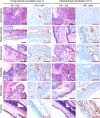Ocular conjunctival inoculation of SARS-CoV-2 can cause mild COVID-19 in rhesus macaques
- PMID: 32879306
- PMCID: PMC7467924
- DOI: 10.1038/s41467-020-18149-6
Ocular conjunctival inoculation of SARS-CoV-2 can cause mild COVID-19 in rhesus macaques
Abstract
Severe acute respiratory syndrome coronavirus 2 (SARS-CoV-2) is highly transmitted through the respiratory route, but potential extra-respiratory routes of SARS-CoV-2 transmission remain uncertain. Here we inoculated five rhesus macaques with 1 × 106 TCID50 of SARS-CoV-2 conjunctivally (CJ), intratracheally (IT), and intragastrically (IG). Nasal and throat swabs collected from CJ and IT had detectable viral RNA at 1-7 days post-inoculation (dpi). Viral RNA was detected in anal swabs from only the IT group at 1-7 dpi. Viral RNA was undetectable in tested swabs and tissues after intragastric inoculation. The CJ infected animal had a higher viral load in the nasolacrimal system than the IT infected animal but also showed mild interstitial pneumonia, suggesting distinct virus distributions. This study shows that infection via the conjunctival route is possible in non-human primates; further studies are necessary to compare the relative risk and pathogenesis of infection through these different routes in more detail.
Conflict of interest statement
The authors declare no competing interests.
Figures




References
-
- Deng, C. et al. Ocular dectection of SARS-CoV-2 in 114 cases of COVID-19 pneumonia in Wuhan, China: an observational study.SSRN Electron. J.10.2139/ssrn.3543587 (2020).
Publication types
MeSH terms
Substances
LinkOut - more resources
Full Text Sources
Miscellaneous

